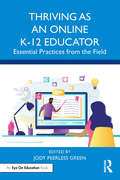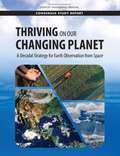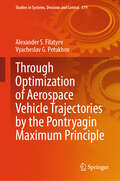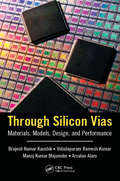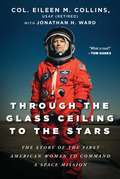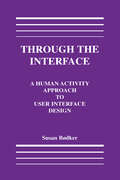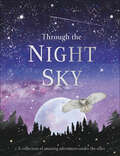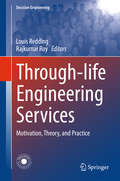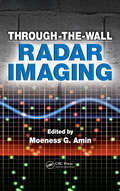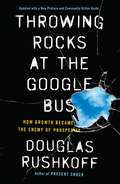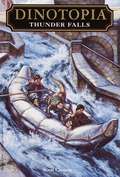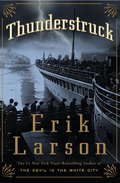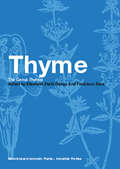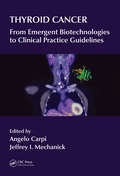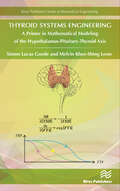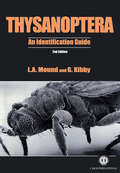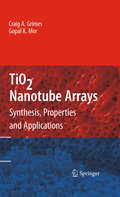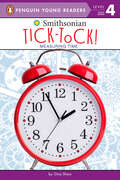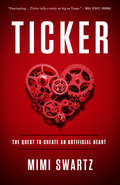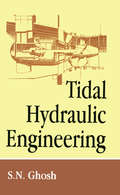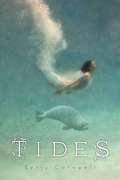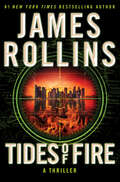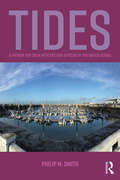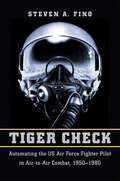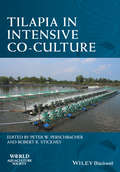- Table View
- List View
Thriving as an Online K-12 Educator: Essential Practices from the Field
by Jody Peerless GreenThriving as an Online K-12 Educator is the perfect all-in-one guide to taking your K-12 class online. We know, now more than ever, that teachers have not been equally or systematically trained and resourced to make a sudden transition to online or blended instruction. This concise, accessible book collects time-tested strategies and fresh perspectives from experienced educators to help you smooth out even the most abrupt shift to technology-enhanced teaching and learning. With these insights into institutional supports, effective digital tools, equitable practice, social-emotional considerations, and beyond, you will be better prepared than ever to help your students thrive in online and blended learning environments.
Thriving on Our Changing Planet: A Decadal Strategy For Earth Observation From Space
by Engineering Medicine National Academies of SciencesWe live on a dynamic Earth shaped by both natural processes and the impacts of humans on their environment. It is in our collective interest to observe and understand our planet, and to predict future behavior to the extent possible, in order to effectively manage resources, successfully respond to threats from natural and human-induced environmental change, and capitalize on the opportunities – social, economic, security, and more – that such knowledge can bring. By continuously monitoring and exploring Earth, developing a deep understanding of its evolving behavior, and characterizing the processes that shape and reshape the environment in which we live, we not only advance knowledge and basic discovery about our planet, but we further develop the foundation upon which benefits to society are built. Thriving on Our Changing Planet presents prioritized science, applications, and observations, along with related strategic and programmatic guidance, to support the U.S. civil space Earth observation program over the coming decade.
Through Optimization of Aerospace Vehicle Trajectories by the Pontryagin Maximum Principle (Studies in Systems, Decision and Control #579)
by Alexander S. Filatyev Vyacheslav G. PetukhovThis monograph investigates the trajectory optimization problems of low- and finite-thrust aerospace vehicles and spacecraft using an indirect method based on the Pontryagin maximum principle, providing a methodological basis for the construction of numerical techniques that are superior in versatility and accuracy to direct methods. This book provides a theoretical explanation of the approaches used and also an extensive gallery of the results of practical numerical studies. The problem of boundary value problem convergence has been largely overcome, which has made it possible to practically automate the optimization of trajectories and to achieve a qualitative generalization with a number of fundamentally new results. Examples of practical optimization of branching trajectories of complex dynamics systems with finite and continual sets of branches, in deterministic and stochastic statements, with control constraints and phase constraints of various orders are demonstrated. An emphasis is placed on the consistent application of methods of numerical continuation with respect to a parameter to solve various problems in the flight mechanics of spacecraft with an electric propulsion system (EPS). The problems considered include the optimization of direct interplanetary flights of spacecraft with thrusters having limited power or limited thrust, of interplanetary flights of such spacecraft using gravity assisted maneuvers, of multi-orbit interorbital transfers of spacecraft with limited-thrust EPS. As a result, it was possible to develop a set of numerical continuation methods for solving a wide range of optimization problems for spacecraft trajectories with EPS with improved characteristics in terms of convergence and performance. This monograph also contains a description of many pitfalls in solving a wide range of problems of optimizing the trajectories of aerospace vehicles and recipes for effectively overcoming them.
Through Silicon Vias: Materials, Models, Design, and Performance
by Brajesh Kumar Kaushik Manoj Kumar Majumder Vobulapuram Ramesh Kumar Arsalan AlamRecent advances in semiconductor technology offer vertical interconnect access (via) that extend through silicon, popularly known as through silicon via (TSV). This book provides a comprehensive review of the theory behind TSVs while covering most recent advancements in materials, models and designs. Furthermore, depending on the geometry and physical configurations, different electrical equivalent models for Cu, carbon nanotube (CNT) and graphene nanoribbon (GNR) based TSVs are presented. Based on the electrical equivalent models the performance comparison among the Cu, CNT and GNR based TSVs are also discussed.
Through the Glass Ceiling to the Stars: The Story of the First American Woman to Command a Space Mission
by Jonathan H. Ward Col. Eileen M. Collins UsafThe long-awaited memoir of a trailblazer and role model who is telling her story for the first time. <p><p> Eileen Collins was an aviation pioneer her entire career, from her crowning achievements as the first woman to command an American space mission as well as the first to pilot the space shuttle to her early years as one of the Air Force's first female pilots. She was in the first class of women to earn pilot's wings at Vance Air Force Base and was their first female instructor pilot. She was only the second woman pilot admitted to the Air Force's elite Test Pilot Program at Edwards Air Force Base. NASA had such confidence in her skills as a leader and pilot that she was entrusted to command the first shuttle mission after the Columbia disaster, returning the US to spaceflight after a two-year hiatus. Since retiring from the Air Force and NASA, she has served on numerous corporate boards and is an inspirational speaker about space exploration and leadership. <p><p> Eileen Collins is among the most recognized and admired women in the world, yet this is the first time she has told her story in a book. It is a story not only of achievement and overcoming obstacles but of profound personal transformation. The shy, quiet child of an alcoholic father and struggling single mother, who grew up in modest circumstances and was an unremarkable student, she had few prospects when she graduated from high school, but she changed her life to pursue her secret dream of becoming an astronaut. She shares her leadership and life lessons throughout the book with the aim of inspiring and passing on her legacy to a new generation.
Through the Interface: A Human Activity Approach To User Interface Design
by Susanne BodkerIn providing a theoretical framework for understanding human- computer interaction as well as design of user interfaces, this book combines elements of anthropology, psychology, cognitive science, software engineering, and computer science. The framework examines the everyday work practices of users when analyzing and designing computer applications. The text advocates the unique theory that computer application design is fundamentally a collective activity in which the various practices of the participants meet in a process of mutual learning.
Through the Night Sky: A collection of amazing adventures under the stars (Journey Through)
by DKA beautifully illustrated collection of nonfiction stories featuring the many wonders that exist in the night sky.Beginning with a sunset and ending at dawn, Through the Night Sky shines a light on the magical events taking place in the darkness above. Unlike an astronomy book that focuses on eye-popping facts and figures about the universe, Through the Night Sky features a series of incredible stories that take place in the sky at night. Track a colony of bats as they fly through the twilight to pollinate the flowers of the mysterious baobab tree, follow a family into the wilderness to gaze at the constellations, watch whales swimming through chilly Arctic waters under the gentle glow of the Northern Lights, then chart the journey of a ship navigating by the stars. Through the Night Sky is a beautiful book that spans a wide range of subjects, including everything from nocturnal animals or revelers watching fireworks illuminate the night, to celestial objects such as the moon, planets, stars, and meteor showers--all under the vast night sky.
Through-life Engineering Services
by Louis Redding Rajkumar RoyDemonstrating the latest research and analysis in the area of through-life engineering services (TES), this book utilizes case studies and expert analysis from an international array of practitioners and researchers - who together represent multiple manufacturing sectors: aerospace, railway and automotive - to maximize reader insights into the field of through-life engineering services. As part of the EPSRC Centre in Through-life Engineering Services program to support the academic and industrial community, this book presents an overview of non-destructive testing techniques and applications and provides the reader with the information needed to assess degradation and possible automation of through-life engineering service activities . The latest developments in maintenance-repair-overhaul (MRO) are presented with emphasis on cleaning technologies, repair and overhaul approaches and planning and digital assistance. The impact of these technologies on sustainable enterprises is also analyzed. This book will help to support the existing TES community and will provide future studies with a strong base from which to analyze and apply techn9olgical trends to real world examples.
Through-the-Wall Radar Imaging
by Moeness G. AminThrough-the-wall radar imaging (TWRI) allows police, fire and rescue personnel, first responders, and defense forces to detect, identify, classify, and track the whereabouts of humans and moving objects. Electromagnetic waves are considered the most effective at achieving this objective, yet advances in this multi-faceted and multi-disciplinary technology require taking phenomenological issues into consideration and must be based on a solid understanding of the intricacies of EM wave interactions with interior and exterior objects and structures. Providing a broad overview of the myriad factors involved, namely size, weight, mobility, acquisition time, aperture distribution, power, bandwidth, standoff distance, and, most importantly, reliable performance and delivery of accurate information, Through-the-Wall Radar Imaging examines this technology from the algorithmic, modeling, experimentation, and system design perspectives. It begins with coverage of the electromagnetic properties of walls and building materials, and discusses techniques in the design of antenna elements and array configurations, beamforming concepts and issues, and the use of antenna array with collocated and distributed apertures. Detailed chapters discuss several suitable waveforms inverse scattering approaches and revolve around the relevance of physical-based model approaches in TWRI along with theoretical and experimental research in 3D building tomography using microwave remote sensing, high-frequency asymptotic modeling methods, synthetic aperture radar (SAR) techniques, impulse radars, airborne radar imaging of multi-floor buildings strategies for target detection, and detection of concealed targets. The book concludes with a discussion of how the Doppler principle can be used to measure motion at a very fine level of detail. The book provides a deep understanding of the challenges of TWRI, stressing its multidisciplinary and phenomenological nature. The breadth and depth of topics covered presents a highly detailed treatment of this potentially life-saving technology.
Throwing Rocks at the Google Bus
by Douglas RushkoffWhy doesn't the explosive growth of companies like Facebook and Uber deliver more prosperity for everyone? What is the systemic problem that sets the rich against the poor and the technologists against everybody else? When protesters shattered the windows of a bus carrying Google employees to work, their anger may have been justifiable, but it was misdirected. The true conflict of our age isn't between the unemployed and the digital elite, or even the 99 percent and the 1 percent. Rather, a tornado of technological improvements has spun our economic program out of control, and humanity as a whole--the pro-testers and the Google employees as well as the shareholders and the executives--are all trapped by the consequences. It's time to optimize our economy for the human beings it's supposed to be serving. In this groundbreaking book, acclaimed media scholar and author Douglas Rushkoff tells us how to combine the best of human nature with the best of modern technology. Tying together disparate threads--big data, the rise of robots and AI, the increasing participation of algorithms in stock market trading, the gig economy, the collapse of the eurozone--Rushkoff provides a critical vocabulary for our economic moment and a nuanced portrait of humans and commerce at a critical crossroads.From the Hardcover edition.
Thunder Falls (Dinotopia Series)
by Scott CiencinTwo young dinosaurs learn the value of cooperation when they are sent on a quest for a hidden prize.
Thunderstruck
by Erik LarsonA true story of love, murder, and the end of the world&’s &“great hush.&”In Thunderstruck, Erik Larson tells the interwoven stories of two men—Hawley Crippen, a very unlikely murderer, and Guglielmo Marconi, the obsessive creator of a seemingly supernatural means of communication—whose lives intersect during one of the greatest criminal chases of all time.Set in Edwardian London and on the stormy coasts of Cornwall, Cape Cod, and Nova Scotia, Thunderstruck evokes the dynamism of those years when great shipping companies competed to build the biggest, fastest ocean liners; scientific advances dazzled the public with visions of a world transformed; and the rich outdid one another with ostentatious displays of wealth. Against this background, Marconi races against incredible odds and relentless skepticism to perfect his invention: the wireless, a prime catalyst for the emergence of the world we know today. Meanwhile, Crippen, &“the kindest of men,&” nearly commits the perfect murder.With his unparalleled narrative skills, Erik Larson guides us through a relentlessly suspenseful chase over the waters of the North Atlantic. Along the way, he tells of a sad and tragic love affair that was described on the front pages of newspapers around the world, a chief inspector who found himself strangely sympathetic to the killer and his lover, and a driven and compelling inventor who transformed the way we communicate.
Thyme: The Genus Thymus (Medicinal And Aromatic Plants - Industrial Profiles Ser. #Vol. 24)
by Elisabeth Stahl-Biskup Francisco SáezThe genus Thymus consists of about 350 species of perennial, aromatic herbs and subshrubs native to Europe and North Africa. Various types of thyme are used all over the globe as condiments, ornamentals and sources of essential oil. Thyme oil (distilled from its leaves) is among the world's top ten essential oils, displaying antibacterial, antimyco
Thyroid Cancer: From Emergent Biotechnologies to Clinical Practice Guidelines
by Jeffrey I. Mechanick Angelo CarpiThe current age of clinical medicine is witnessing biotechnological innovation at an unprecedented pace. As a result, the recently popularized clinical practice guidelines (CPG), as a tool to assist clinical decision-making, have been struggling to keep up. Thyroid Cancer: From Emergent Biotechnology to Clinical Practice Guidelines rides the wave o
Thyroid Systems Engineering: A Primer in Mathematical Modeling of the Hypothalamus-Pituitary-Thyroid Axis
by Simon Goede Melvin Khee-Shing LeowIn recent years, a considerable amount of effort has been devoted, both in industry and academia, towards the behavioral modeling, evaluation and prediction of the hypothalamus pituitary thyroid system.Thyroid Systems Engineering targets an optimal treatment of people suffering from thyroid hormone disorders. The content is motivated by in-depth observations of such patients whose rich data supported the theoretical framework arising from formal mathematical reasoning, guided by the nature of thyroid physiology. Leveraging on the insights emerging from the unique combination of an electrical engineer working with a clinical thyroidologist, and both being scientists skilled in mathematics, the authors introduce this new discipline and field of scientific investigation aptly designated as Thyroid Systems Engineering.Readers will discover that mathematics can indeed model the behavior of the hypothalamus-pituitary-thyroid (HPT) axis. Focused on modeling, each of the eighteen chapters gives the reader a notion of the application of relevant mathematics to pertinent issues encountered in mainstream thyroidology. Many cellular processes resemble the flux of variables and states in a complex multi-parameter space through time analogous to current flow in electrical networks. It is then logical to apply the principles and physical laws of electrodynamics, electrical network theory, control systems theory and signal theory to many of the biological phenomena encountered in endocrinology. Such an approach is used liberally throughout the book and successfully yields elegant solutions to a number of models presented within.This book can serve as a reference to mathematical modeling in other aspects of endocrine physiology, and as the starting point for a fundamental course in medical modeling. It will appeal to postgraduates in electrical engineering, academic physicians and biomedical researchers. Further, readers equipped with advanced calculus, electrical network theory, control theory and signal theory should be able to follow the mathematical expositions that describe thyrotropic control. They represent a new discipline based on mathematical modeling in physiology applicable to medical diagnostics, measurement and treatment to cooperate in the clinical team and realize an optimized treatment for patients.
Thysanoptera: An Identification Guide, 2nd Edition
by Laurence Mound Geoffrey KibbyA number of species of Thysanoptera (thrips) are increasingly important crop pests in many parts of the world, as well as in some cases being vectors of plant disease. Communicating the known information about a species of organism is dependent on our ability to recognise or identify it accurately. This book is a completely revised and rewritten edition of the standard, widely used manual on these minute flying insects written by J M Palmer, L A Mound and G J du Heaume and published in 1989 as CIE Guides to Insects of Importance to Man 2. Thysanoptera, which provides a practical identification guide on a worldwide scale. The previous version posed problems for students in terms of fluency in English & knowledge of dichotomous keys. However, this thoroughly updated edition incorporates a new set of pictorial keys, which have been developed and used very successfully for training courses at the International Institute of Entomology and which will greatly enhance the ability of the non-specialist to identify thrips to species. Individuals of these insects can usually be identified only by examination under a microscope, often at high power. Within each species, individuals can vary in size, colour and shape and their appearance can be altered by techniques used in preparation. This booklet describes techniques used in the preparation of thrip specimens onto slides for identification and the means of identifying slide-mounted specimens most commonly encountered. It also introduces students to the biological diversity that is found amongst the Thysanoptera, their economic importance in terms of both damaging and beneficial effects, new identification techniques, additional information and taxa, glossary of technical terms, notes on each genus (described alphabetically within their families and subfamilies). Supplementary keys to species are also given within four genera that include several pest species (Caliothrips, Frankliniella, Scirtothrips and Thrips) along with new distribution records which have occurred since the publication of the first edition. It is an essential tool for applied entomologists and crop protection specialists involved in the control of crop pest thrips, and thrip taxonomists.
TiO2 Nanotube Arrays
by Craig A. Grimes Gopal K. MorTiO2 Nanotube Arrays: Synthesis, Properties, and Applications is the first book to provide an overview of this rapidly growing field. Vertically oriented, highly ordered TiO2 nanotube arrays are unique and easily fabricated materials with an architecture that demonstrates remarkable charge transfer as well as photocatalytic properties. This volume includes an introduction to TiO2 nanotube arrays, as well as a description of the material properties and distillation of the current research. Applications considered include gas sensing, heterojunction solar cells, water photoelectrolysis, photocatalytic CO2 reduction, as well as several biomedical applications. Written by leading researchers in the field, TiO2 Nanotube Arrays: Synthesis, Properties, and Applications is a valuable reference for chemists, materials scientists and engineers involved with renewable energy sources, biomedical engineering, and catalysis, to cite but a few examples.
Tick-Tock!: Measuring Time (Smithsonian)
by Gina ShawWhat time is it . . . and how do you know?This fact- and photo-filled Smithsonian Penguin Young Reader will fill you in on how people first began measuring time and why knowing "when" is important.Time is when things happen and how long they take to happen--but how long is all that? The history of telling time is the history of inventions and communication, from hour glasses to atomic clocks, from calendars to chronometers. Tick-Tock is a fun look at the many ways different people have tried to get in sync.
Ticker: The Quest to Create an Artificial Heart
by Mimi SwartzIt wasn’t supposed to be this hard. If America could send a man to the moon, shouldn’t the best surgeons in the world be able to build an artificial heart? In Ticker, Texas Monthly executive editor and two time National Magazine Award winner Mimi Swartz shows just how complex and difficult it can be to replicate one of nature’s greatest creations. Part investigative journalism, part medical mystery, Ticker is a dazzling story of modern innovation, recounting fifty years of false starts, abysmal failures and miraculous triumphs, as experienced by one the world’s foremost heart surgeons, O.H. “Bud” Frazier, who has given his life to saving the un-savable. His journey takes him from a small town in west Texas to one of the country’s most prestigious medical institutions, The Texas Heart Institute, from the halls of Congress to the animal laboratories where calves are fitted with new heart designs. The roadblocks to success —medical setbacks, technological shortcomings, government regulations – are immense. Still, Bud and his associates persist, finding inspiration in the unlikeliest of places. A field beside the Nile irrigated by an Archimedes screw. A hardware store in Brisbane, Australia. A seedy bar on the wrong side of Houston. Until post WWII, heart surgery did not exist. Ticker provides a riveting history of the pioneers who gave their all to the courageous process of cutting into the only organ humans cannot live without. Heart surgeons Michael DeBakey and Denton Cooley, whose feud dominated the dramatic beginnings of heart surgery. Christian Barnaard, who changed the world overnight by performing the first heart transplant. Inventor Robert Jarvik, whose artificial heart made patient Barney Clark a worldwide symbol of both the brilliant promise of technology and the devastating evils of experimentation run amuck. Rich in supporting players, Ticker introduces us to Bud’s brilliant colleagues in his quixotic quest to develop an artificial heart: Billy Cohn, the heart surgeon and inventor who devotes his spare time to the pursuit of magic and music; Daniel Timms, the Brisbane biomedical engineer whose design of a lightweight, pulseless heart with but a single moving part offers a new way forward. And, as government money dries up, the unlikeliest of backers, Houston’s furniture king, Mattress Mack. In a sweeping narrative of one man’s obsession, Swartz raises some of the hardest questions of the human condition. What are the tradeoffs of medical progress? What is the cost, in suffering and resources, of offering patients a few more months, or years of life? Must science do harm to do good? Ticker takes us on an unforgettable journey into the power and mystery of the human heart.
Tidal Hydraulic Engineering
by S.N. GhoshThe text on tidal hydraulic engineering includes discussion of: basic characterstics of tides and tidal propagation; hydrographic surveys in tidal rivers; and design considerations for tidal sluice gates for drainage and fish farms in aquaculture.
Tides
by Betsy CornwellWhen high school senior Noah Gallagher and his adopted teenage sister, Lo, go to live with their grandmother in her island cottage for the summer, they don't expect much in the way of adventure. Noah has landed a marine biology internship, and Lo wants to draw and paint, perhaps even to vanquish her struggles with bulimia. But then things take a dramatic turn for them both when Noah mistakenly tries to save a mysterious girl from drowning. This dreamlike, suspenseful story--deftly told from multiple points of view--dives deeply into selkie folklore while examining the fluid nature of love and family.e kind and harmless Noah, and when she finds out that her elder has had a decades long romance with a human, she lets him into her secret world of selkie shape-shifters and ancient magic. When the kidnapper strikes again, Mara can no longer trust her feelings or Noah. He and Lo must prove his innocence before they can join Mara in her fight to unravel the mystery of the kidnapper's identity and save her family.
Tides of Fire: A Sigma Force Novel (Sigma Force #17)
by James RollinsIn the latest riveting thriller from James Rollins, the #1 New York Times bestselling author of the Sigma Force series, an international research station in the Coral Sea comes under siege during a geological disaster that triggers massive quakes, deadly tsunamis, and volcanic eruptions. To stop the world from burning, it’s up to Sigma Force to uncover a secret buried at the heart of our planet. The Titan Project—an international research station off the coast of Australia—discovers a thriving zone of life in an otherwise dead sea. The area teems with a strange bioluminescent coral that defies science, yet holds great promise for the future. But the loss of a military submarine in the area triggers a brutal attack and sets in motion a geological disaster that destabilizes an entire region.Massive quakes, volcanic eruptions, and deadly tsunamis herald a greater cataclysm to come—for something is stirring miles under the ocean, a threat hidden for millennia.As seas turn toxic and coastlines burn, can Sigma Force stop what has been let loose—especially as an old adversary returns, hunting them and thwarting their every move? For any hope of success, Commander Gray Pierce must search for a key buried in the past, hidden deep in Aboriginal mythology. But what Sigma could uncover is even more frightening—something that will shake the very foundations of humanity.
Tides: A Primer for Deck Officers and Officer of the Watch Exams
by Philip M. SmithTides: A Primer for Deck Officers and Officer of the Watch Exams prepares the reader for the Officer of the Watch and Master/Mate certificates required by all officers on commercial seagoing vessels. From the formation of tides and tidal stream data, right through to practice questions with answers, and even mock exam papers, this book will provide you with all the reference material you need in order to pass your exams.
Tiger Check: Automating the US Air Force Fighter Pilot in Air-to-Air Combat, 1950–1980
by Steven A. FinoHow did American fighter pilots respond to the challenges posed by increasing automation?Spurred by their commanders during the Korean War to be "tigers," aggressive and tenacious American fighter pilots charged headlong into packs of fireball-spewing enemy MiGs, relying on their keen eyesight, piloting finesse, and steady trigger fingers to achieve victory. But by the 1980s, American fighter pilots vanquished their foes by focusing on a four-inch-square cockpit display, manipulating electromagnetic waves, and launching rocket-propelled guided missiles from miles away. In this new era of automated, long-range air combat, can fighter pilots still be considered tigers? Aimed at scholars of technology and airpower aficionados alike, Steven A. Fino’s Tiger Check offers a detailed study of air-to-air combat focusing on three of the US Air Force’s most famed aircraft: the F-86E Sabre, the F-4C Phantom II, and the F-15A Eagle. Fino argues that increasing fire control automation altered what fighter pilots actually did during air-to-air combat. Drawing on an array of sources, as well as his own decade of experience as an F-15C fighter pilot, Fino unpacks not just the technological black box of fighter fire control equipment, but also fighter pilots’ attitudes toward their profession and their evolving aircraft. He describes how pilots grappled with the new technologies, acutely aware that the very systems that promised to simplify their jobs while increasing their lethality in the air also threatened to rob them of the quintessential—albeit mythic—fighter pilot experience. Finally, Fino explains that these new systems often required new, unique skills that took time for the pilots to identify and then develop. Eschewing the typical "great machine" or "great pilot" perspectives that dominate aviation historiography, Tiger Check provides a richer perspective on humans and machines working and evolving together in the air. The book illuminates the complex interactions between human and machine that accompany advancing automation in the workplace.
Tilapia in Intensive Co-culture
by Robert R. Stickney Peter PerschbacherIntensive tilapia co-culture is the commercial production of various species of tilapia in conjunction with one or more other marketable species. Tilapia are attractive as a co-cultured fish because of their potential to improve water quality, especially in penaeid shrimp ponds, by consuming plankton and detritus and by altering pathogenic bacterial populations while increasing marketable production. Following introductory chapters covering ecological aspects of co-culture, tilapia feeding habits, historical use, and new models, Tilapia in Intensive Co-Culture is divided into co-culture in freshwater and marine environments. Co-culture core information is presented on Vibrio control, high-rate aquaculture processes, aquaponics, tilapia nutrient profile, and tilapia niche economics and marketing in the U.S, and with carp, catfish, freshwater and marine shrimp in the Americas, the Middle East, and Asia. Tilapia in Intensive Co-Culture is the latest book in the prestigious World Aquaculture Society (WAS) Series, published for WAS by Wiley Blackwell. It will be of great use and interest to researchers, producers, investors and policy makers considering tilapia co-culture in terms of environmental and economic sustainability.
